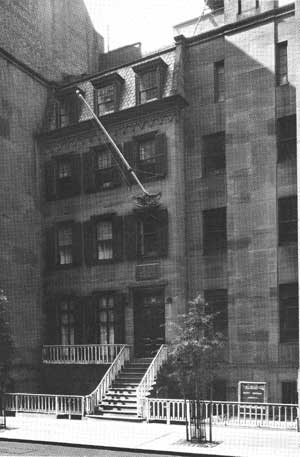






Survey of
Historic Sites and Buildings
 |
Theodore Roosevelt Birthplace National Historic
Site New York |
 Theodore Roosevelt Birthplace |
| ||
On this site stands a reconstruction of the four-story, brownstone townhouse where Theodore Roosevelt was born and spent the first 14 years of his life. During these formative years, he waged a victorious struggle against persistent childhood ailments and poor health; nurtured a passion for books and learning; and, with the help of exercise and a loving family, created a strong body and molded a vigorous personality.
In 1854 Roosevelt's father, also named Theodore, brought his bride from Georgia to New York City and moved into a residence at No. 33 (later No. 28) East 20th Street. It had been built in 1848 either by or for the elder Theodore's brother, Robert Barnwell Roosevelt. After 1854, the former occupied the adjacent house to the west.
During the nearly two decades the Roosevelts lived in the house, all four of their children were born in it. Theodore, Jr., born in October 1858, suffered from poor health from the beginning of his life. Physically unable to attend school, he received some tutoring, but gained his education primarily on his own by extensive reading. When he was 10 years old, he accompanied his parents on a grand tour of Europe, a major ordeal for him because of illness, homesickness, and physical exhaustion. Two years later, his father installed gymnasium equipment off the nursery on the second-floor porch. From that time on, Theodore assiduously tried to better his health, which had improved considerably by the time the family made a second trip to Europe in 1872-73. In the latter year, when the Roosevelts arrived back in New York, they moved into another home, at 6 West 57th Street.
 |
| Theodore Roosevelt Birthplace National Historic Site (National Park Service, Zane, 1976.) |
The birthplace house remained in the Roosevelt family until 1896. Gradually, however, as the surrounding neighborhood passed from a residential to a commercial area, it underwent a series of transformations that obliterated its original character. By 1919, shortly after Roosevelt's death, the newly organized Woman's Roosevelt Memorial Association purchased the site, then occupied by a two-story brick commercial structure, as well as the adjacent home, where Robert Barnwell Roosevelt had lived. In 1921-23, following a successful fund-raising drive, the association reconstructed the birthplace home and converted the adjoining building into a museum and office. At the same time, the two structures, which had only been connected by a door leading from one porch to the other on the second floor, were made into a single unit.
Except for a few bricks used in the cornerstone, the birthplace was totally rebuilt. Every effort, however, was made to duplicate the prototype house. The Roosevelt Memorial Association, incorporated in 1919, contributed sizable amounts of money to the project, and, at the invitation of the Woman's Association, placed its extensive collection of books, manuscripts, photographs, and other Roosevelt memorabilia in the two houses. In 1956 the two associations merged under the name of the Theodore Roosevelt Association; 7 years later, it donated to the U.S. Government the reconstructed birthplace home and Sagamore Hill, which is described elsewhere in this volume.
The basement of the combined buildings houses exhibit rooms and other public facilities. The first floor contains the restored parlor, library, and dining room, and a museum room. The second floor consists of a refurnished bedroom approximating the one in which Roosevelt was born, the nursery, porch on which Roosevelt's father installed gymnasium equipment, library, and study. Office facilities occupy the third floor. The fourth floor, which features an auditorium, projection booth, and dressing rooms, accommodates meetings, programs, and other activities. Furnishings in the restored portions of the present building include many original Roosevelt items, and the museum preserves thousands of objects, pictures, and documents relating to his personal and public life.
 |
 |
http://www.cr.nps.gov/history/online_books/presidents/site42.htm
Last Updated: 04-Feb-2004